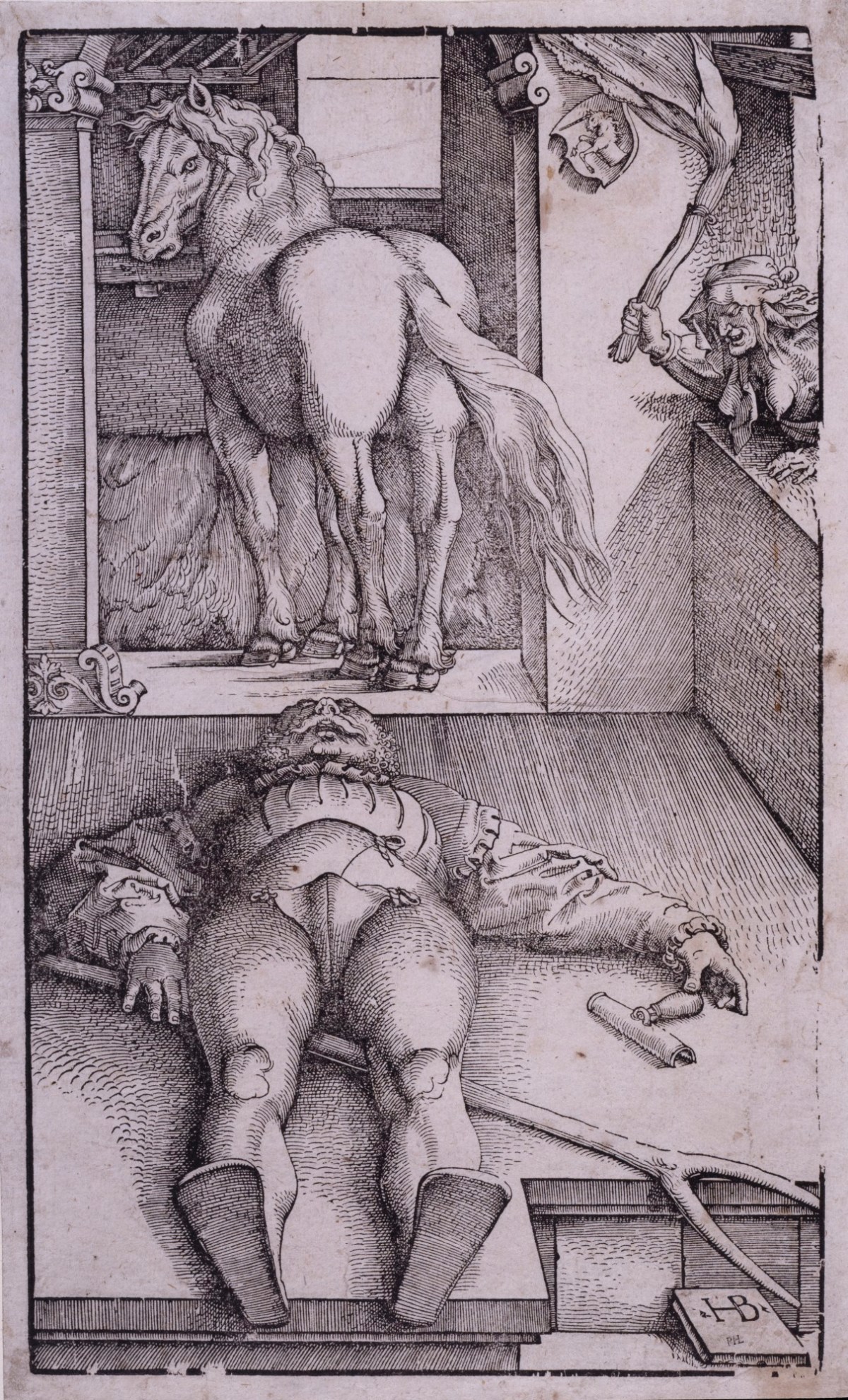
Hans Baldung Grien, Bewitched Groom, 1544/45.
Woodcut. 340 mm x 200 mm. © Photo: Royal Academy of Arts, London. Photographer: John Hammond.
This image is not available to download. To licence this image for commercial purposes, contact our Picture Library at picturelibrary@royalacademy.org.uk
Bewitched Groom, 1544/45
Hans Baldung Grien (1484 or 1485 - September 1545)
RA Collection: Art
This woodcut by the German artist Hans Baldung (called Grien) is one of the most enigmatic images in Renaissance art. Although it is known as The Bewitched Groom, the print was not given a title by the artist himself and its ambiguous subject matter has puzzled generations of scholars.
The scene is apparently set inside a stable where a groom lies on the ground with his currycomb and pitchfork, his horse stands in its stall looking back towards the viewer with a sinister glare and a bare-breasted hag leans through the window brandishing a flaming torch. Baldung's bold use of foreshortening and perspective seems designed to disconcert rather than convince the viewer and creates a general sense of eeriness and unease in the composition.
Witches and supernatural subjects feature prominently in Baldung's drawings, prints and paintings. Given this background, the fearsome old woman on the right is usually identified as a sorceress. Belief in witches was commonplace during Baldung's lifetime and they were thought to be able to control both humans and animals through demonic possession. The three protagonists depicted here have been linked with German folk tales about witchcraft, but the print defies exact comparison with any particular story. If the woman on the right is a witch, it still remains unclear exactly what she is doing. We do not know if she has bewitched the groom, killed him or caused the horse to kick him.
Alternative explanations suggest that the print is not a narrative but an allegory, either of lust, anger or death. In Baldung's work, both witches and horses are portrayed as wild, lustful and dangerous, indicating that the print could be read as a warning against lasciviousness or against the 'sleep of reason' when fantasy takes over the rational mind. The print has also been described as a metaphorical self-portrait of the artist because the coat of arms on the wall bears his own heraldic device, the unicorn. The Bewitched Groom was made a year before Baldung's death and has been explained as an expression of his fears about the human condition and his own demise. Given Baldung's particular fondness for supernatural subject matter, there may even be a hint of satire in this unsettling image.
An alternative interpretation of the print has recently been put forward by the Renaissance specialist Jennifer Sliwka who suggests that the figure of the witch could, more specifically, be a personification of envy. She points to the clear similarity between the 'witch' depicted here and the figure of envy, or Invidia, in the engraving of Andrea Mantegna's <i>A Battle of the Sea Gods </i> who appears as a naked hag with sagging breasts sitting on a sea monster. Sliwka notes that 'the term 'Invidia' derives from the Latin<i>invidere</i> meaning 'to look too closely' and traditionally this was the vice most associated with witches ... as they were believed to possess the power to cast a curse with a malevolent glare, known as the Evil Eye'. Envy was traditionally thought to originate from the eyes and witches were thought to cast spells or 'bewitch' through their gaze. Sliwka suggests that the woman could be interpreted as one who envies the groom's horse and might be attempting to steal it and, more broadly, that the image could itself be an 'allegory of looking' in which the witch's envious gaze mirrors that of Baldung's own artistic rivals.
Object details
340 mm x 200 mm



